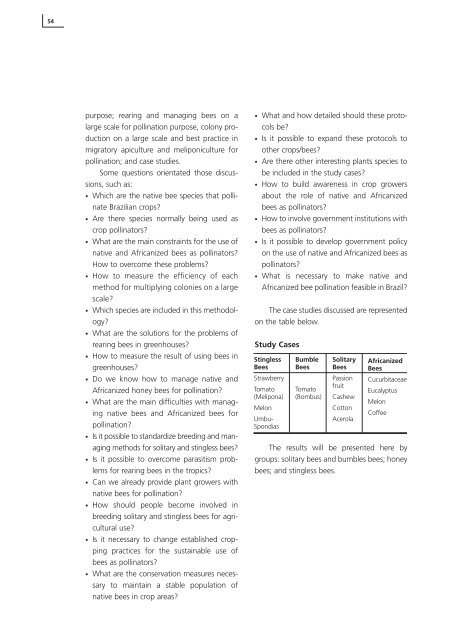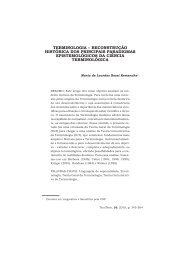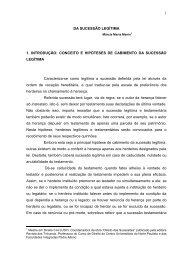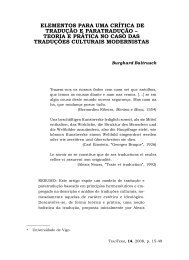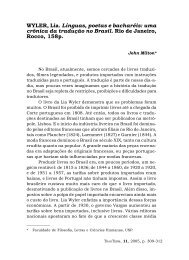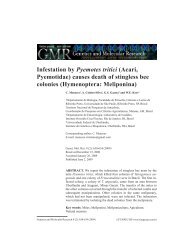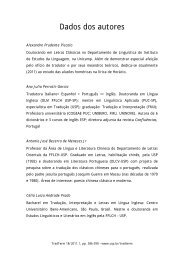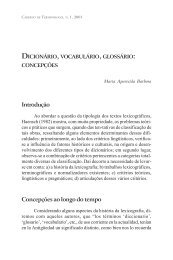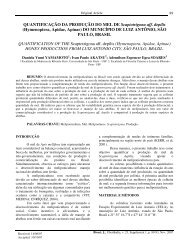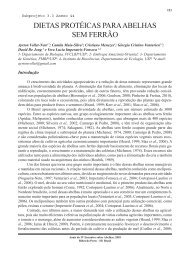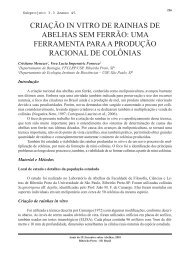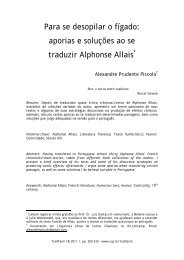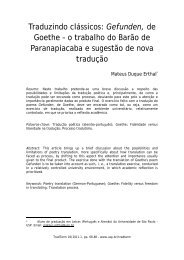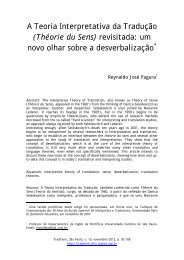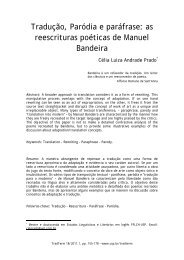Bees as pollinators in Brazil - USP
Bees as pollinators in Brazil - USP
Bees as pollinators in Brazil - USP
You also want an ePaper? Increase the reach of your titles
YUMPU automatically turns print PDFs into web optimized ePapers that Google loves.
54<br />
purpose; rear<strong>in</strong>g and manag<strong>in</strong>g bees on a<br />
large scale for poll<strong>in</strong>ation purpose, colony production<br />
on a large scale and best practice <strong>in</strong><br />
migratory apiculture and meliponiculture for<br />
poll<strong>in</strong>ation; and c<strong>as</strong>e studies.<br />
Some questions orientated those discussions,<br />
such <strong>as</strong>:<br />
• Which are the native bee species that polli-<br />
nate <strong>Brazil</strong>ian crops?<br />
• Are there species normally be<strong>in</strong>g used <strong>as</strong><br />
crop <strong>poll<strong>in</strong>ators</strong>?<br />
• What are the ma<strong>in</strong> constra<strong>in</strong>ts for the use of<br />
native and Africanized bees <strong>as</strong> <strong>poll<strong>in</strong>ators</strong>?<br />
How to overcome these problems?<br />
• How to me<strong>as</strong>ure the efficiency of each<br />
method for multiply<strong>in</strong>g colonies on a large<br />
scale?<br />
• Which species are <strong>in</strong>cluded <strong>in</strong> this methodol-<br />
ogy?<br />
• What are the solutions for the problems of<br />
rear<strong>in</strong>g bees <strong>in</strong> greenhouses?<br />
• How to me<strong>as</strong>ure the result of us<strong>in</strong>g bees <strong>in</strong><br />
greenhouses?<br />
• Do we know how to manage native and<br />
Africanized honey bees for poll<strong>in</strong>ation?<br />
• What are the ma<strong>in</strong> difficulties with manag<strong>in</strong>g<br />
native bees and Africanized bees for<br />
poll<strong>in</strong>ation?<br />
• Is it possible to standardize breed<strong>in</strong>g and manag<strong>in</strong>g<br />
methods for solitary and st<strong>in</strong>gless bees?<br />
• Is it possible to overcome par<strong>as</strong>itism problems<br />
for rear<strong>in</strong>g bees <strong>in</strong> the tropics?<br />
• Can we already provide plant growers with<br />
native bees for poll<strong>in</strong>ation?<br />
• How should people become <strong>in</strong>volved <strong>in</strong><br />
breed<strong>in</strong>g solitary and st<strong>in</strong>gless bees for agricultural<br />
use?<br />
• Is it necessary to change established cropp<strong>in</strong>g<br />
practices for the susta<strong>in</strong>able use of<br />
bees <strong>as</strong> <strong>poll<strong>in</strong>ators</strong>?<br />
• What are the conservation me<strong>as</strong>ures necessary<br />
to ma<strong>in</strong>ta<strong>in</strong> a stable population of<br />
native bees <strong>in</strong> crop are<strong>as</strong>?<br />
• What and how detailed should these proto-<br />
cols be?<br />
• Is it possible to expand these protocols to<br />
other crops/bees?<br />
• Are there other <strong>in</strong>terest<strong>in</strong>g plants species to<br />
be <strong>in</strong>cluded <strong>in</strong> the study c<strong>as</strong>es?<br />
• How to build awareness <strong>in</strong> crop growers<br />
about the role of native and Africanized<br />
bees <strong>as</strong> <strong>poll<strong>in</strong>ators</strong>?<br />
• How to <strong>in</strong>volve government <strong>in</strong>stitutions with<br />
bees <strong>as</strong> <strong>poll<strong>in</strong>ators</strong>?<br />
• Is it possible to develop government policy<br />
on the use of native and Africanized bees <strong>as</strong><br />
<strong>poll<strong>in</strong>ators</strong>?<br />
• What is necessary to make native and<br />
Africanized bee poll<strong>in</strong>ation fe<strong>as</strong>ible <strong>in</strong> <strong>Brazil</strong>?<br />
The c<strong>as</strong>e studies discussed are represented<br />
on the table below.<br />
Study C<strong>as</strong>es<br />
St<strong>in</strong>gless<br />
<strong>Bees</strong><br />
Strawberry<br />
Tomato<br />
(Melipona)<br />
Melon<br />
Umbu-<br />
Spondi<strong>as</strong><br />
Bumble<br />
<strong>Bees</strong><br />
Tomato<br />
(Bombus)<br />
Solitary<br />
<strong>Bees</strong><br />
P<strong>as</strong>sion<br />
fruit<br />
C<strong>as</strong>hew<br />
Cotton<br />
Acerola<br />
Africanized<br />
<strong>Bees</strong><br />
Cucurbitaceae<br />
Eucalyptus<br />
Melon<br />
Coffee<br />
The results will be presented here by<br />
groups: solitary bees and bumbles bees; honey<br />
bees; and st<strong>in</strong>gless bees.


